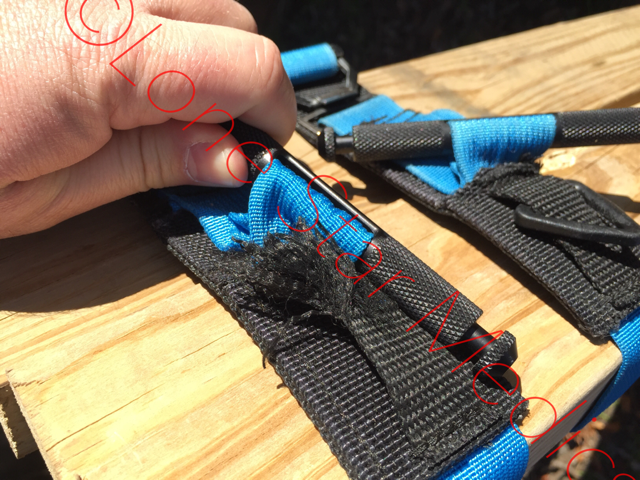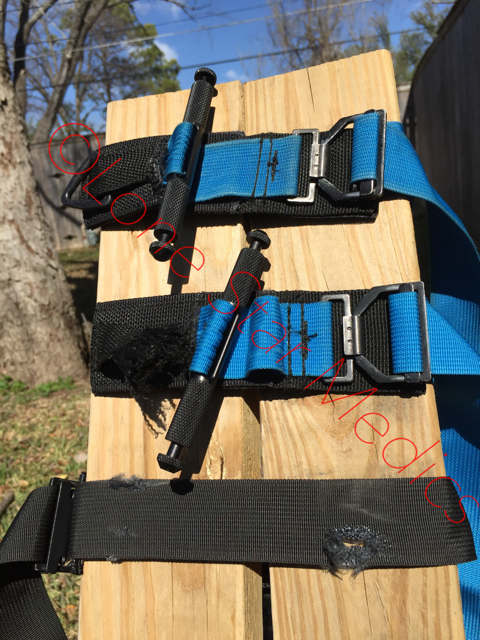During our Medic 1 course at Lone Star Medics, while learning how to apply a tourniquet, a few students found out the importance of designating a tourniquet for training purposes only and not using their everyday carry tourniquet for both training and the real world. Throughout our courses, we allow students to explore the benefits and deficiencies of several different manufacturers’ products firsthand. We teach them to “treat their patient, not their equipment.” Meaning, don’t focus so much on what tool is needed, but focus on the jobs of finding out what the problem is, developing a solution, and using the tools available to assist with solving that problem. As students progress through class, they quickly learn the value of quality medical equipment. Funny how that works when trying to save lives.

After several hundred applications in training, the windlass was abrasive enough to finally wear down the stitching on the anchoring device strap. A testament to the strength of the SOFTT-Wide. Photo: author
USING AND ABUSING TOURNIQUETS WHILE TRAINING
While conducting a scenario involving one patient (role player) and two rescuers (students), the students identified major bleeding and started to apply a SOFTT-Wide on the patient’s extremity. As the student was about to anchor the windlass into the plastic triangle, the triangle popped off and the entire windlass spun loose. Neither the plastic triangle nor the windlass broke. The webbing strip that holds the plastic triangle anchoring device had come undone. The students were both shocked and a bit taken aback at the fact they had broken a pretty solid piece of equipment. The SOFTT-Wide has a long history and reputation of being one of the finest commercially made tourniquets. At the time of this writing, it is one of only two tourniquets approved by the Committee on Tactical Combat Casualty Care (CoTCCC).
If you’re not familiar with CoTCCC, it is a group of U.S. military doctors, nurses, and medics/corpsmen that oversees the medical training and medical equipment of our military. They’re pretty much the leading experts in modern combat medicine. My point is that the SOFTT-Wide has been through some pretty epic testing, evaluations, and research. It has saved numerous lives both on the battlefield and on the streets here at home. So to have it “fail” is something of an oddity.
After investigating what exactly had happened, I came to the conclusion that the sewn nylon strap that holds the anchoring device (plastic triangle) in place had been exposed to quite a bit of abrasive wear and tear. As you can see in the photos, when the windlass is turned by hand, it does rub up against the tourniquet itself. It just so happens to rub up against the sewn end of that small nylon strap that holds the anchoring device in place.
You need to understand that the SOFTT-Wide, like a lot of consumable medical products, is designed for one-time use only. It was never intended to be applied and taken off several times during its life span. Granted this tourniquet is made of strong materials that are designed to withstand exposure to sand, debris, mud, snow and ice, wind, and temperature extremes — but only for so long. Short of being made out of unicorn horns, any material will break down after being exposed to such elements. And the tourniquet in this class did not break down because of the elements. It broke due to extreme use and abuse.
TACTICAL MEDICAL SOLUTIONS
When you want answers, you go to the top, and Ross Johnson is the head dude at Tactical Medical Solutions, maker of the SOFTT-Wide. When I showed Ross the problem, he immediately understood what had happened. He called his lead guy who does all the sewing for TMS. Within a few minutes they had identified the issue, created a few options to fix it and, before he hung up the phone, things were moving toward a few solutions. And this is not a design or manufacturing flaw. It is an end-user flaw.
You’d be hard pressed to find another company or business owner that aggressive or passionate about their products saving lives. Ross and I started doing some very rough estimates on how many times that single tourniquet might have been applied throughout its lifetime. I calculated that during the time frame we had that tourniquet in our possession, we had approximately four to six classes, with an average of 10 to 15 students per class. I cannot keep track of how many times every single tourniquet I have in my inventory of training supplies was used in each class. But I can say that each student has the opportunity to apply a tourniquet to themselves or another student, a role player, or even Rescue Randy (a full-size training mannequin) a dozen or more times per class, per day. Some classes are two days in length, which means more hands-on skills practice with the tourniquets.
When applying tourniquets to Rescue Randy, students typically are a little more aggressive than when they apply them to actual humans. While learning and practicing how to apply a tourniquet, students may get in 20 or 30 repetitions per class. Now imagine if each student traded off one single tourniquet during those skills practice sessions. See what I mean about “rough estimates”? Taking all that into consideration, I came up with a modest approximation of 200 to 250 times that particular SOFTT-Wide had been applied during about a six-month time frame. Obviously that far exceeds anything the manufacturer designed it for.

Top to bottom: A SOFTT-Wide trainer in good shape. Middle tourniquet lost its stitching after several hundred applications. Bottom tourniquet was torn up during training after students applied it and then had to utilize a proper dragging technique to move the patient to safety. It maintained original placement on the patient and was 100% intact upon completion of the scenario. Yet it is no longer viable for real-world use. Photo: author
THE DRAG FACTOR
Another example of the need for dedicated training tourniquets is when we were training a group of federal law enforcement officers in our Medicine X course. During a live-fire scenario, two officers who knew how to apply a tourniquet dragged Rescue Randy behind cover, applied a SOFTT-Wide to Randy’s leg, and then had to drag the mannequin even farther as part of the scenario. When finished, we noticed the tourniquet had a hole in it and obvious signs of tearing. This was due to it being dragged over 50 yards across the range’s concrete surface. Even though it was torn up a bit, it still stayed on the patient and probably would have maintained occlusion of the artery. A tourniquet made of weaker material (rubber or elastic) would not have survived that scenario, and poor Randy would have bled out and died.
WHAT CAN WE LEARN FROM THIS?
Having quality medical gear is essential, but even quality gear can break when abused beyond its intentions. You also need to be training with medical gear; just not your everyday carry medical gear. The SOFTT-Wide comes in three different colors: black, orange, and blue. In our courses, we use the blue SOFTT-Wides and, since these incidents occurred, we’ve numbered each training tourniquet as well. I won’t be keeping track of how many times each one is used in class, but at least I can keep some accountability with them. Tactical Medical Solutions and North American Rescue (makers of the C.A.T.) both have “training blue” options available for purchase.
Don’t forget to inspect your real-world tourniquets regularly. I personally check my EDC medical gear every week (Tactical Medical Solutions Ankle Medical Kit). I check for torn packaging, loose threads or stitching, and of course expiration dates. The good thing about having expired medical equipment or medical gear with some wear and tear is that it may not be suitable for real-world use. But depending on what it is, you can now use it for training … and only for training!
Obviously I’m a strong advocate of continuing your medical training outside the classroom. Just make sure you’re not abusing your life-saving equipment beyond what it is designed for. Everything has a limit or breaking point, even quality gear.
Nice piece of information. Learned long ago while n the military that you don't go to war with your training equipment, as it should be considered unserviceable for operational usage.
Outstanding presentation and information about tourniquets and the correct way to use them. Thank you
Great info.Thanks
Thanks for the article ,Victor
Thanks for the current info
I have been using Chinook Medical for supplies and training supplies. I noticed you didn't mention them as a source for supplies. Any thoughts?
great
was navy corpsman some years ago. would like to know where to purchase training medical gear.(tourniquets, israeli bandages etc.) at a reasonable price for training purposes. would like to be prepared in case any disasters occur in my area.
Great article, many good points. I agree you should check your on-duty at regular intervals and designate aging gear to the training trenches.